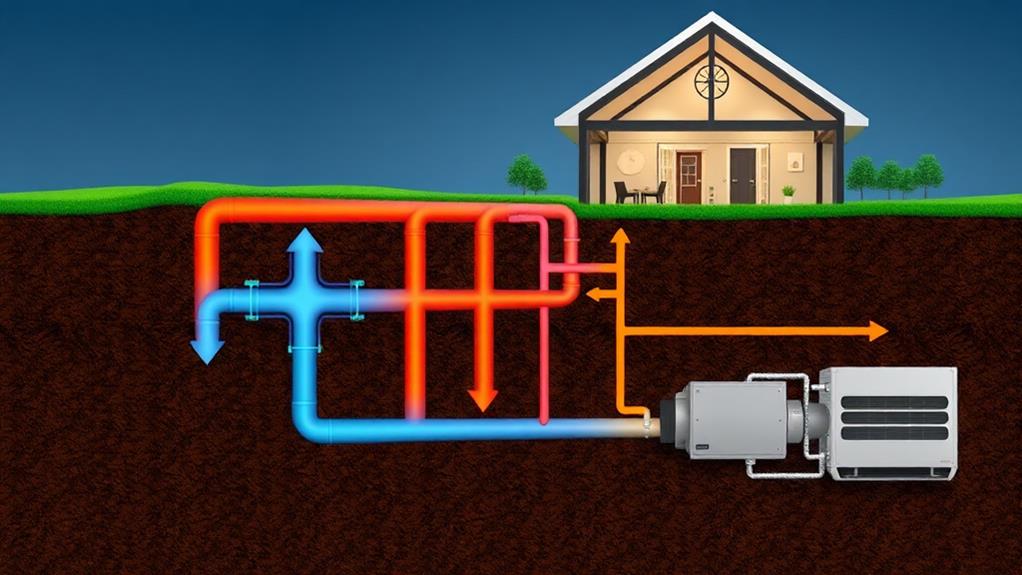Geothermal HVAC systems tap into the Earth's constant underground temperature to heat and cool your home efficiently. They use a network of pipes filled with water or refrigerant to transfer heat between your house and the ground. While upfront costs are higher, you'll save 25-50% on electricity compared to conventional systems. These eco-friendly units produce fewer emissions, have a smaller carbon footprint, and don't burn fossil fuels on-site. They're also quieter and more comfortable, enhancing your living experience. With indoor components lasting 20-25 years and ground loops lasting 50+ years, geothermal systems offer long-term benefits. Discover how this sustainable technology can transform your home's climate control.
Understanding Geothermal HVAC Systems
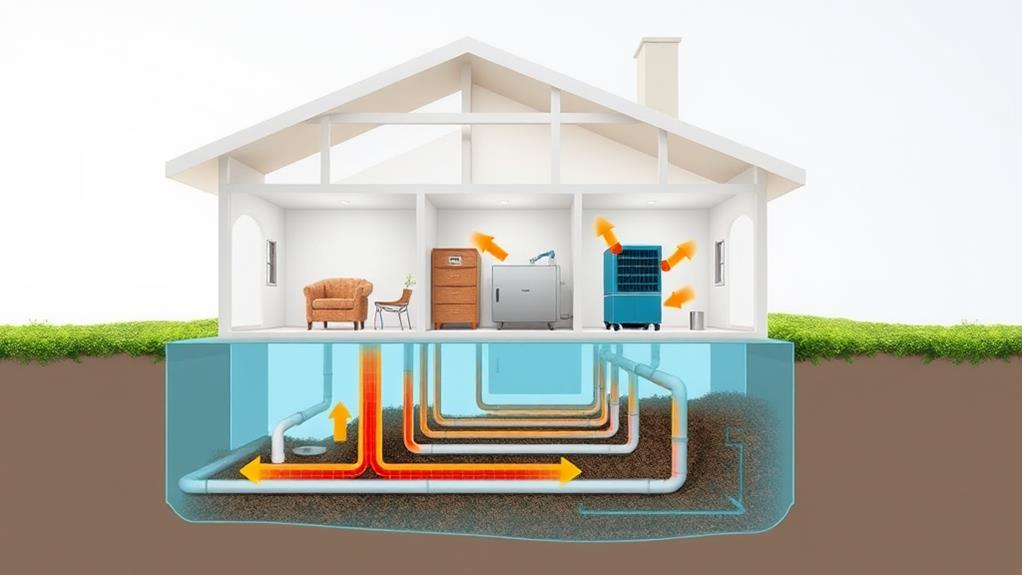
Geothermal HVAC systems harness the Earth's stable underground temperature to heat and cool buildings efficiently. These systems work by circulating a fluid through a network of underground pipes, called a ground loop. The fluid absorbs heat from the Earth during winter and releases heat into the ground during summer.
You'll find that geothermal systems consist of three main components: the ground loop, a heat pump, and a distribution system. The ground loop exchanges heat with the Earth, while the heat pump transfers this energy to or from your home. The distribution system then circulates the heated or cooled air throughout your building.
Unlike traditional HVAC systems that rely on outdoor air temperature, geothermal systems take advantage of the constant temperature below ground, typically ranging from 45°F to 75°F. This consistency allows for more efficient operation year-round. You'll notice that geothermal systems don't require outdoor units, making them quieter and less obtrusive than conventional air-source heat pumps or air conditioners.
Components of Geothermal Systems
Now that you understand the basics of geothermal HVAC systems, let's examine their key components in more detail. A typical geothermal system consists of three main parts: the ground loop, the heat pump, and the distribution system.
The ground loop is a network of pipes buried underground that circulates a fluid to transfer heat between the earth and your home. It can be installed horizontally or vertically, depending on your property's size and soil conditions.
The heat pump is the heart of the system, extracting heat from the ground loop in winter and reversing the process in summer. It's typically located indoors and contains a compressor, heat exchanger, and refrigerant to efficiently transfer heat.
The distribution system delivers heated or cooled air throughout your home. This can be through traditional ductwork or radiant floor heating. Some systems also include a desuperheater, which captures excess heat from the heat pump to provide hot water.
Additionally, you'll find controls and thermostats to regulate the system's operation and maintain your desired indoor temperature. These components work together to create an efficient, eco-friendly heating and cooling solution for your home.
Installation Process
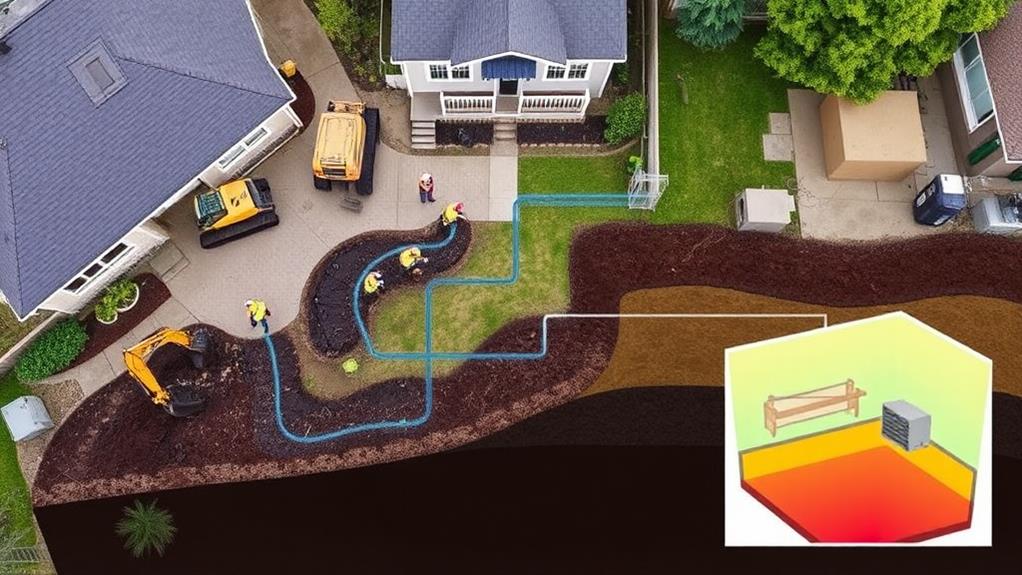
The journey to a comfortable, eco-friendly home begins with the installation of a geothermal HVAC system. You'll start by having a professional assess your property to determine the best loop system for your needs. They'll consider factors like soil composition, available land, and your home's heating and cooling requirements.
Next, you'll need to excavate the area for the ground loops. For horizontal systems, this involves digging trenches, while vertical systems require drilling deep boreholes. The loops are then laid and connected to the heat pump inside your home.
Inside, the heat pump is installed, typically in your basement or utility room. It's connected to your home's existing ductwork or to a new distribution system if you're retrofitting an older home.
The final steps involve connecting the indoor and outdoor components, installing the thermostat, and testing the system. Your contractor will also balance the airflow and make any necessary adjustments to ensure optimal performance.
Throughout the process, you'll need to obtain proper permits and schedule inspections to meet local building codes. While the installation can be disruptive, the long-term benefits of your geothermal system will far outweigh the temporary inconvenience.
Energy Efficiency and Cost Savings
Once your geothermal HVAC system is up and running, you'll start reaping the benefits of its impressive energy efficiency and cost savings. Geothermal systems can reduce your energy consumption by up to 70% compared to traditional HVAC systems. This efficiency stems from their ability to leverage the earth's consistent underground temperature, requiring less energy to heat or cool your home.
You'll notice a significant decrease in your monthly utility bills, often seeing savings of 30-60% on heating and 20-50% on cooling costs. While the initial installation cost is higher, you can expect to recoup this investment within 5-10 years through energy savings alone.
Additionally, geothermal systems have a longer lifespan, typically lasting 20-25 years for indoor components and 50+ years for ground loops, reducing long-term replacement costs. These systems also qualify for various tax incentives and rebates, further offsetting initial costs. By using renewable energy, you'll reduce your carbon footprint and contribute to environmental conservation.
With minimal maintenance requirements and consistent performance regardless of outdoor weather conditions, geothermal HVAC systems offer unparalleled efficiency and cost-effectiveness for your home or business.
Environmental Impact
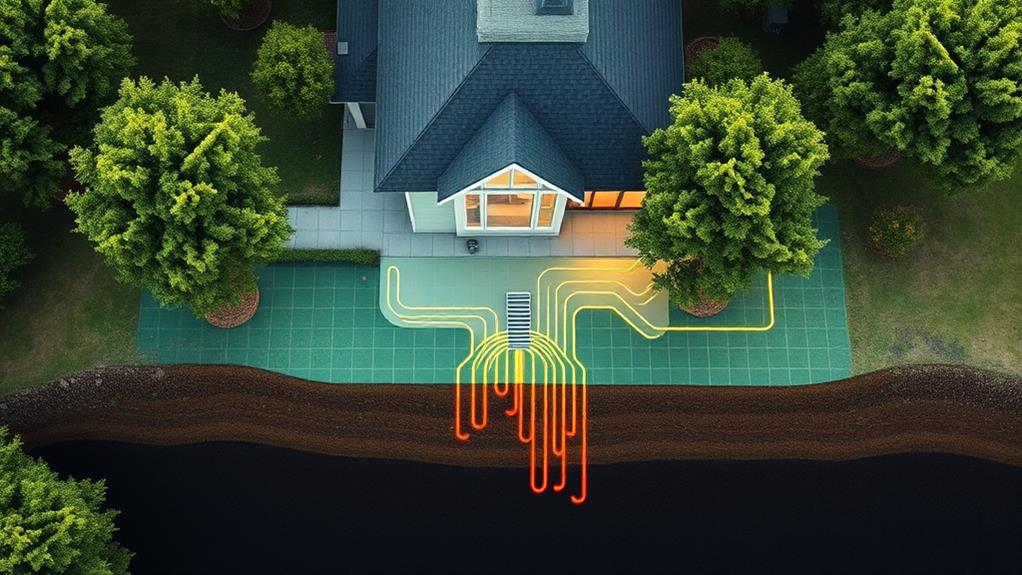
In light of growing environmental concerns, geothermal HVAC systems stand out as a remarkably eco-friendly heating and cooling solution. Unlike traditional HVAC systems that rely heavily on fossil fuels, geothermal systems harness the Earth's natural heat, significantly reducing your carbon footprint. You'll be pleased to know that these systems emit no greenhouse gases directly, contributing to cleaner air and a healthier environment.
By using the constant temperature of the Earth, geothermal systems don't require the burning of fuel for heating or extensive energy consumption for cooling. This means you're not only saving money but also conserving valuable natural resources. Additionally, geothermal systems have a longer lifespan than conventional HVAC units, reducing the need for frequent replacements and the associated waste.
You'll also appreciate that geothermal systems don't require outdoor units, preserving your property's aesthetic appeal and reducing noise pollution. Furthermore, they use non-toxic refrigerants, minimizing the risk of harmful chemical leaks. By choosing a geothermal HVAC system, you're making a responsible choice that benefits both your immediate surroundings and the global environment.
Maintenance and Longevity
Homeowners considering geothermal HVAC systems will be pleased to learn about their impressive longevity and minimal maintenance requirements. These systems typically last 20-25 years for indoor components and 50+ years for ground loops, significantly outlasting traditional HVAC systems.
You'll find that maintenance for geothermal systems is relatively simple. Annual check-ups by a professional are recommended to ensure optimal performance. During these inspections, technicians will examine the heat pump, clean or replace filters, and check refrigerant levels. The ground loop system rarely requires maintenance due to its protected underground location.
One of the key advantages of geothermal systems is their reduced wear and tear. With fewer moving parts compared to conventional HVAC units, there's less chance of component failure. You won't need to worry about outdoor units exposed to harsh weather conditions, as everything is safely housed indoors or underground.
To maximize your system's lifespan, keep the area around the indoor unit clean and unobstructed. Regularly change or clean air filters as recommended by the manufacturer. By following these simple maintenance steps, you'll ensure your geothermal HVAC system continues to operate efficiently for decades.
Comparing Geothermal to Traditional HVAC
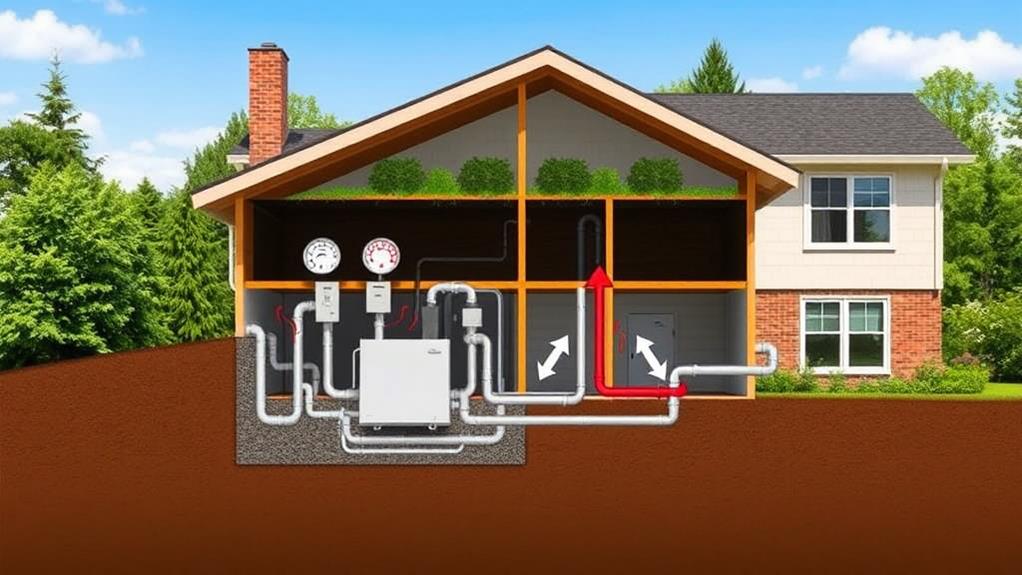
When comparing geothermal HVAC systems to their traditional counterparts, you'll find several key differences. Geothermal systems use the earth's constant temperature to heat and cool your home, while traditional HVAC relies on outdoor air temperature. This makes geothermal systems more efficient, as they don't have to work as hard to maintain comfort levels.
You'll notice that geothermal systems have higher upfront costs but lower operating expenses over time. They typically use 25-50% less electricity than conventional systems, resulting in significant energy savings. Geothermal HVACs also have a longer lifespan, often lasting 20-25 years for indoor components and 50+ years for ground loops, compared to 10-15 years for traditional systems.
Environmental impact is another crucial difference. Geothermal systems produce fewer greenhouse gas emissions and have a smaller carbon footprint. They don't burn fossil fuels on-site, reducing your home's environmental impact. Additionally, geothermal systems operate more quietly than traditional HVAC units, which can be noisy, especially during startup. You'll appreciate the peace and quiet that comes with a geothermal system, enhancing your overall comfort at home.
Conclusion
You've now explored the ins and outs of geothermal HVAC systems. They're efficient, eco-friendly, and can save you a pretty penny in the long run. While the initial investment might seem steep, it's worth its weight in gold. Don't be a stick in the mud – embrace this technology that's been around since the days of Archimedes. With proper maintenance, your geothermal system will keep you comfortable for years to come.
